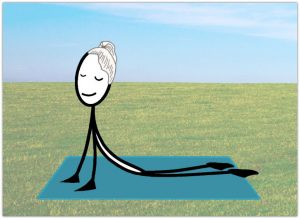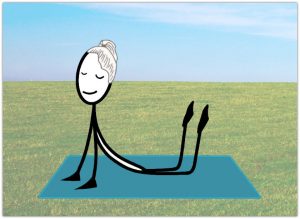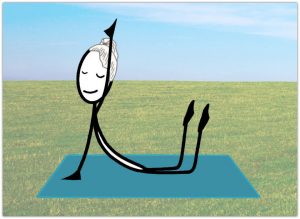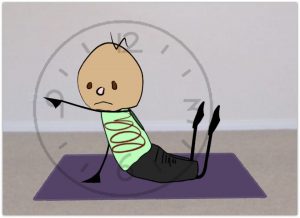Experiencing Running Injuries? Test to See if the Culprit’s Tight Hip Flexors
Dear A & H…Remember how my back used to hurt?…Then, if that weren’t enough, the recent bouts of Achilles tendonitis. Would you believe it, all because of tight hip flexors! Wish it didn’t take so long to figure out but, it’s all good. Since learning how to test their flexibility, it’s easier keeping tabs on them. An important tool for any runner’s toolbox, it’s this week’s topic. ت
Proper Running Form
No matter the distance or terrain, an essential element of running comfortably and efficiently is proper form.
Namely, good technique.
There are some differences of opinion as to what this might look like, what is ideal or most important focusing on. However, many acknowledge the following as important:
- Slight forward lean.
- Forefoot or midfoot strike.
Sounds reasonable.
Sounds simple.
Yet, for some, trying to coordinate these recommendations with pacing and controlled breathing leaves many feeling like they’ve just entered a fighting match with themselves.
It’s a strange thing. Tasked with just two things to be mindful of, body alignment and foot placement, we’re feeling nothing but awkward.
Everything just feels “off.”
Feeling “Off”
There could be two reasons for this.
One, if these two suggestions are much different than what we’re already doing, the awkwardness is just a matter of transition. We’re trying to change something that’s second nature into something different. Eventually, with time, practice, and patience, whatever we’re trying to change becomes the new normal, a new second nature.
The second reason for feeling awkward is functional imbalances, either lack of flexibility and/or strength.
Focusing on just flexibility for the moment, what many of us might not realize, most likely because we don’t think about it, having mastered walking and running as babies, is this motion’s origin. The obvious answer would be the legs and feet. A good answer but not quite complete. They’re essential and necessary, yes, but, without hips, especially those that can be described as “flexible,” legs and feet can’t do their job optimally.
It’s the same with swimming except, as hips are to runners, shoulders are to swimmers. Synonymous structures doing synonymous work. Basically, if they’re in good functional order, proper arm and hand placement are easier to come by. This, in turn, translates to better performance. Lacking shoulder flexibility, however, no matter how fit or strong the swimmer, it won’t translate when in the water. Without flexibility, stroke power is not so much lost as never having a chance to emerge in the first place.
The Fallout From Inflexibility
Since swimming was my first venue into competitive sports, with its vigilant attention to proper technique, this naturally had me do the same when I started running.
This was just my normal and served me well because, other than two cases of plantar fasciitis and one case of iliotibial band syndrome my first year running competitively (diagnosis: over-excitement for my new pastime), I’ve had no significant injuries since.
Except, that is, until recently. Starting around 2016, my charmed running life ended. In its place came regular bouts of calf tightness, two cases of Achilles tendonitis, and the reawakening of the demon in my back (i.e. low back pain).
Hmm, must be the age. Getting old…body’s not snapping back the way it used to. Muscle tone is harder to maintain…tendons tightening up like piano wire…
Actually, no, that wasn’t it. Well, maybe 2% the reason. 😕
The real culprit was this website.
Yep…
Completely true.
The Sneaky Saboteur
Up until 2015, the fateful year I started working on this site, I usually was on my feet all the time. Then, as happens when facing a computer screen for a great portion of the day, I sat.
It wasn’t obvious at first. There were no symptoms or signs to cause worry. But, with time, it became obvious.
Sitting was sabotaging my running form.
It was robbing my body of strength and, most importantly, flexibility.
It was the reason behind all the new injuries.
So, while being on my feet was usually the norm, allowing me to sustain flexibility without even trying, sitting was doing the opposite.
It did a number on my hip flexors.
It did it rather quickly, too.
I should have known.
What you don’t use, you lose.
But, it was eventually remedied and, with a few simple movements I do on a regular basis, it’s easy for me to determine if they’re staying limber or seizing up again.
How About You?
Now come a few important questions.
Do you sit most the day?
Then, at night, sleep in a fetal position most the night?
If yes, your body (i.e. hip flexors) may be tighter than you realize. Nothing to worry about but something to consider if you want to develop your best running form while reducing the risk of injury.
With that in mind, here’s a simple way to test hip flexibility.
Testing Hip Flexors
There are a couple ways to test hip flexibility, one being the Thomas test, a simple examination requiring only a sturdy table and observer.
It’s informative but the one I prefer is even simpler, taking just a few seconds of time.
All that’s needed is a floor and, of course, you.
It’s based on the cobra pose and only requires three “easy” movements.
Here goes. 🙂
1. Lie on your stomach and rise up into the cobra pose. Make note of your shoulders. Keep them relaxed, even consciously drop your scapula (shoulder blades). Keep the chest open and neck long.
2. Next, bend knees 90 degrees so that your toes point toward the ceiling. For extra balance, move hands forward a little.
3. Finally, simply raise your left hand directly in front and over your head (hand at 12 o’clock).
4. That done, do this same movement with your right hand.
How’d you do?
Were you able to raise your hand without hesitation to the 12 o’clock position?
If yes, awesome! Your hip flexors are doing well.
If not, the news is both bad and good.
The bad news? Those tight hip flexors might be sabotaging your running form like they did mine, leading to both acute and chronic injuries. You probably know the list. They’re common running issues:
- tendonitis
- low back pain
- loss of mobility
- muscle weakness (ex. gluteal muscles).
The good news? It’s not too difficult loosening them up again.
Whew!
I can attest to this because, doing this the first time, I could only raise my hand to about 10 o’clock.
I was unhappily and shockingly tight.
Long story short, I eventually found a way to regain flexibility and reach 12 o’clock. 🙂
Best of all, the effort to get there wasn’t a chore. It’s so enjoyable and beneficial, in fact, it’s become a favorite part of my training.
That’s It For Now
Next week, I’ll share what I discovered.
These are, literally speaking, time-tested movements.
I promise, as they helped me, they’ll help you, too.
A healthy addition to any training plan.
Stay tuned.
Much love, O.M.
P.S. Have you found this post helpful? If “Yes!,” please consider sharing, loving your body with a few miles today, and signing up for notice of new content. Thank you!
P.P.S. No spam ever. Staying away from processed is a healthy thing to do. 🙂






